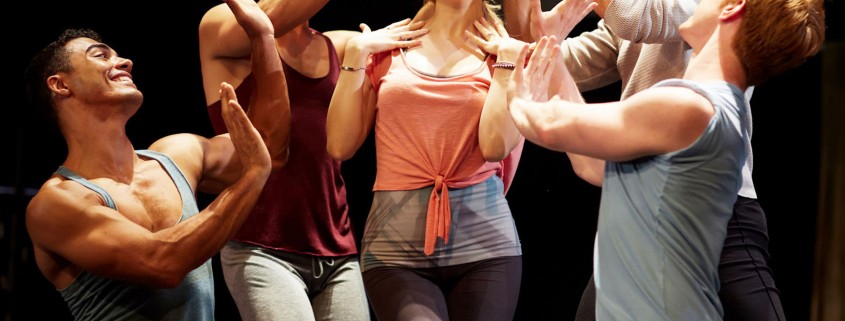Five Years hides heartfelt story in confusing structure
Listen: The Last Five Years has come unstuck in time.
The film shrugs off any and all expectations for a romantic musical, but its non-linear timeline might be one of the most impenetrable aspects for those in the audience coming into the film unfamiliar with the 2001 stage production. The musical follows the arc of the five-year relationship between Cathy Hiatt, played by the always exceptional Anna Kendrick, and Jamie Wellerstein, played by relatively fresh face Jeremy Jordan. The film does not go at this in a straightforward matter.
The Last Five Years follows two timelines: Jamie’s, starting at the beginning going forward, and Cathy’s, starting at the end going backward. This structure allows for some powerful juxtaposition between the rose-colored moments at the beginning of a relationship and the starker ones near its end. If someone is going into the film with no prior knowledge, however, the benefits of this juxtaposition might well be lost. There are no explanations between time jumps. While it is obvious when a jump has happened — there is a jump after every scene — the structure of opposite but linear timelines might be too difficult to pick up. It is easy to mistake the jumps as random.
Director Richard LaGravenese weighed the inclusion of subtitles showing which year it was every time there was a jump, but test audiences reacted against them.
“After each screening, I’d ask them, ‘Do you want subtitles?’ … At every screening 99 percent of the audience said, ‘No, don’t spoon-feed us the story,’” LaGravenese said. “Every audience responded the same, ‘Yes [we were confused] at times, but it didn’t matter. We always knew where we were emotionally.’”
Timelines from his and her perspectives is nothing new. Just last year, The Disappearance of Eleanor Rigby and The Affair, works released within months of each other, were two examples with similar structures. But The Last Five Years is a different animal. As a romantic musical being released on Valentine’s Day weekend, audiences will likely flock to the theater expecting a light celebration of love and instead find themselves confronted with a hard look at the complex nature of relationships. So it goes. But it is only difficult when it needs to be. Where Rigby and The Affair are both saddled with a somber tone throughout, The Last Five Years is not shy to celebrate the good times as well. This is probably what leads to the whiplash that the temporal jumps cause. The tonal shifts are so dramatic from joyous to melancholy that they can be bewildering. Yes, the point is made that relationships can change people, but the test audiences’ concerns about being spoon-fed are slightly comical.
The original musical was sung as a series of soliloquies, so perhaps with the lack of a realized world around the numbers, the emotional highs and lows might need to be more extreme so that the film would not run the risk of being ambiguous, like a silent film actress who exaggerates her facial expressions to compensate for a lack of dialogue.
The film is not subtle, but musicals never are. As a musical, the film is actually quite good. Kendrick is a delight and Jordan is a revelation — at least for those who are not very familiar with the current landscape of musical theater. Kendrick, coming off of the much larger production Into the Woods and the uber-playful Pitch Perfect, is becoming a go-to star for Hollywood musicals. It is difficult to find fault in this strategy. She has an easy, relatable charm combined with impressive vocal ability. The vocals in The Last Five Years were, for the most part, sung live to incorporate the emotions of the actors. Recent history suggests that this strategy runs the risk of ending up with an angry singing Russell Crowe, but here we get another great performance by Kendrick instead. In the opening number “Still Hurting,” in which Kendrick sets the tone for her unsuspecting Valentine’s Day audience by crying and singing alone in her apartment, the live performance allows Kendrick to start the film on an emotional note. The ever humble Kendrick expressed fears of “sounding like a chipmunk,” but her vocal performance proved to be much more Adele than Alvin. In “I Can Do Better Than That,” a much happier song featured in the trailers to further mislead audiences, she hits a fiery high note that makes the whole song.
Jordan, the very capable leading man, more than holds his own. Stemming from a more traditional musical theater background, Jordan knocks his numbers out of the park. Despite LaGravanese’s efforts to keep the characters on equal footing in terms of likeability, Jordan’s character comes up short in this regard. He is by far the less sympathetic of the two characters. But Jordan manages to overcome this and remain quite likable throughout the film. He has amazing ability as a singer and a performer, and he plays off of Kendrick as if he were on equal footing with her in fame.
The film’s structure might be a hindrance to any who go into it without foreknowledge, and this is always a red flag. Any film — unless it is a sequel — should be able to stand on its own without prior knowledge. Despite this, the film overall is quite strong. The performances are impressive and the juxtaposition of the two timelines is a powerful device, when the audience understands what is happening. If The Last Five Years proves difficult to decipher, a second viewing with an understanding of the structure is highly recommended.

